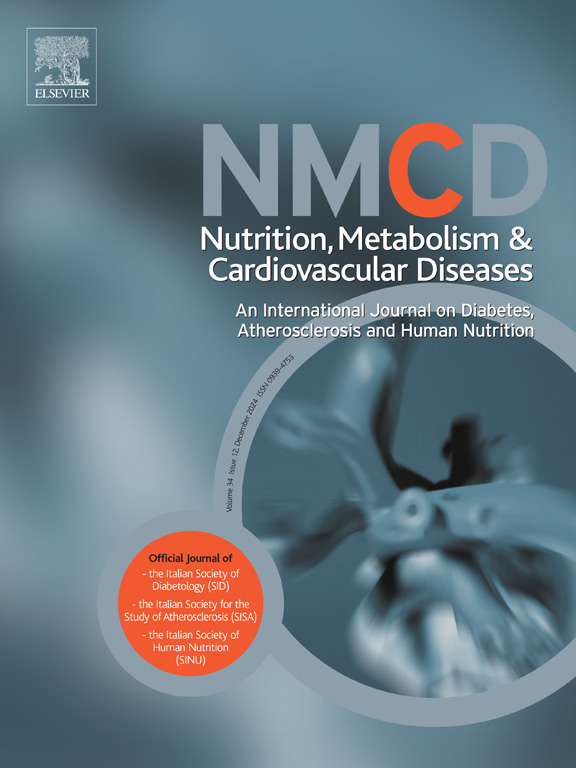The role of gut microbiota in obesity severity and metabolic risk in pediatric populations
IF 3.3
3区 医学
Q2 CARDIAC & CARDIOVASCULAR SYSTEMS
Nutrition Metabolism and Cardiovascular Diseases
Pub Date : 2025-03-08
DOI:10.1016/j.numecd.2025.103970
引用次数: 0
Abstract
Background and aims
Childhood obesity is a considerable public health issue. Recent research has shown that alterations in gut microbiota can have an impact on developing obesity and other metabolic health problems in children. This study aimed to investigate whether the characteristics of gut microbiota in obese children and adolescents are associated with the severity of obesity and any metabolic complications.
Methods and results
During May 2022 to May 2023, a total of 56 children and adolescents with obesity, aged 6–18 years, were recruited at Thammasat Hospital, situated in provincial Pathumthani in central Thailand. Participants were allocated into two groups, characterized by the severity of their obesity. Demographic data, body composition, along with resting energy expenditures were determined. Serum samples were collected for the metabolic profile and inflammatory markers. Fecal samples were obtained for gut microbiota analysis via 16S rRNA Illumina. The obese group exhibited notably greater relative abundance of Actinobacteriota in comparison to the severely obese group, along with a lower abundance of Bacteroidota. There were no statistically significant differences in the relative abundance of Firmicutes and the Firmicutes to Bacteroidota ratio between the two cohorts. Bacteroidota positively correlated with FMI, while Actinobacteriota showed a negative correlation with FMI.
Conclusion
The data gathered from this study illustrated that children and adolescents with obesity and severe obesity in Thailand showed differences in the relative abundance of Actinobacteriota and Bacteroidota. Certain microbiome taxa showed correlations with various body and metabolic parameters.
肠道微生物群在儿童肥胖严重程度和代谢风险中的作用。
背景和目的:儿童肥胖是一个重要的公共卫生问题。最近的研究表明,肠道菌群的改变会对儿童的肥胖和其他代谢健康问题产生影响。本研究旨在探讨肥胖儿童和青少年肠道菌群的特征是否与肥胖的严重程度和任何代谢并发症有关。方法和结果:在2022年5月至2023年5月期间,在泰国中部巴吞他尼省的法政医院招募了56名6-18岁的肥胖儿童和青少年。参与者根据肥胖的严重程度被分为两组。测定了人口统计数据、身体成分以及静息能量消耗。收集血清样本进行代谢谱和炎症标志物检测。采集粪便样本,通过16S rRNA Illumina分析肠道微生物群。与严重肥胖组相比,肥胖组放线菌群的相对丰度明显更高,而拟杆菌群的丰度较低。在两个队列中,厚壁菌门的相对丰度和厚壁菌门与拟杆菌门的比值没有统计学差异。拟杆菌门与FMI呈正相关,放线菌门与FMI呈负相关。结论:本研究收集的数据表明,泰国肥胖和严重肥胖的儿童和青少年在放线菌群和拟杆菌群的相对丰度上存在差异。某些微生物类群与各种身体和代谢参数具有相关性。
本文章由计算机程序翻译,如有差异,请以英文原文为准。
求助全文
约1分钟内获得全文
求助全文
来源期刊
CiteScore
6.80
自引率
2.60%
发文量
332
审稿时长
57 days
期刊介绍:
Nutrition, Metabolism & Cardiovascular Diseases is a forum designed to focus on the powerful interplay between nutritional and metabolic alterations, and cardiovascular disorders. It aims to be a highly qualified tool to help refine strategies against the nutrition-related epidemics of metabolic and cardiovascular diseases. By presenting original clinical and experimental findings, it introduces readers and authors into a rapidly developing area of clinical and preventive medicine, including also vascular biology. Of particular concern are the origins, the mechanisms and the means to prevent and control diabetes, atherosclerosis, hypertension, and other nutrition-related diseases.

 求助内容:
求助内容: 应助结果提醒方式:
应助结果提醒方式:


